
Murray Hill is a neighborhood on the east side of Manhattan in New York City. Murray Hill is generally bordered to the east by the East River or Kips Bay and to the west by Midtown Manhattan, though the exact boundaries are disputed. Murray Hill is situated on a steep glacial hill that peaked between Lexington Avenue and Broadway. It was named after Robert Murray, the head of the Murray family, a mercantile family that settled in the area in the 18th century.
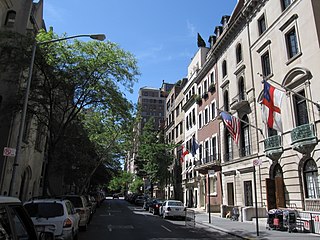
The Upper East Side, sometimes abbreviated UES, is a neighborhood in the borough of Manhattan in New York City, bounded approximately by 96th Street to the north, the East River to the east, 59th Street to the south, and Central Park and Fifth Avenue to the west. The area incorporates several smaller neighborhoods, including Lenox Hill, Carnegie Hill, and Yorkville. Once known as the Silk Stocking District, it has long been the most affluent neighborhood in New York City.

Turtle Bay is a neighborhood in New York City, on the east side of Midtown Manhattan. It extends from roughly 43rd Street to 53rd Street, and eastward from Lexington Avenue to the East River's western branch. The neighborhood is the site of the headquarters of the United Nations and the Chrysler Building. The Tudor City apartment complex is next to the southeast corner of Turtle Bay.

The Otto H. Kahn House is a mansion at 1 East 91st Street, at Fifth Avenue, in the Carnegie Hill section of the Upper East Side of Manhattan in New York City. The four-story mansion was designed by architects J. Armstrong Stenhouse and C. P. H. Gilbert in the neo-Italian Renaissance style. It was completed in 1918 as the town residence of the German-born financier and philanthropist Otto H. Kahn and his family. The Convent of the Sacred Heart, a private school, owns the Kahn House along with the adjacent James A. Burden House, which is internally connected. The mansion is a New York City designated landmark and, along with the Burden House, is listed on the National Register of Historic Places.

Stuyvesant Square is the name of both a park and its surrounding neighborhood in the New York City borough of Manhattan. The park is located between 15th Street, 17th Street, Rutherford Place, and Nathan D. Perlman Place. Second Avenue divides the park into two halves, east and west, and each half is surrounded by the original cast-iron fence.

The Central Park West Historic District is located along Central Park West, between 61st and 97th Streets, on the Upper West Side of Manhattan in New York City, United States. The district was added to the National Register of Historic Places on November 9, 1982. The district encompasses a portion of the Upper West Side-Central Park West Historic District as designated by the New York City Landmarks Preservation Commission, and contains a number of prominent New York City designated landmarks, including the Dakota, a National Historic Landmark. The buildings date from the late 19th century to the early 1940s and exhibit a variety of architectural styles. The majority of the district's buildings are of neo-Italian Renaissance style, but Art Deco is a popular theme as well.

Clinton and Russell was a well-known architectural firm founded in 1894 in New York City, United States. The firm was responsible for several New York City buildings, including some in Lower Manhattan.

Edward A. Sargent was an English-born American architect, known for his work on New York City schools, churches, office buildings, clubs, armory and country homes.

Walker & Gillette was an architectural firm based in New York City, the partnership of Alexander Stewart Walker (1876–1952) and Leon Narcisse Gillette (1878–1945), active from 1906 through 1945.
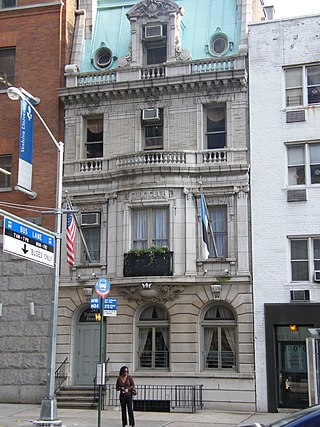
The Civic Club building, now the New York Estonian House, is a four-story Beaux-Arts building located at 243 East 34th Street between Second and Third Avenues in the Murray Hill neighborhood of Manhattan in New York City.
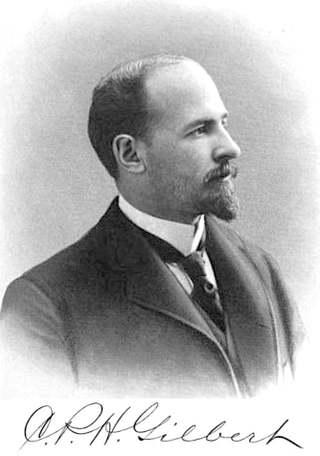
Charles Pierrepont Henry Gilbert was an American architect of the late-19th and early-20th centuries best known for designing townhouses and mansions.

The John Henry Hammond House is a mansion at 9 East 91st Street on the Upper East Side in New York City. Since 1994, the Consulate-General of Russia in New York City has been located there.

The Percy R. Pyne House is a neo-Federal townhouse at 680 Park Avenue, located at the northwest corner of Park Avenue and 68th Street in Manhattan.

The Joseph Raphael De Lamar House is a mansion at 233 Madison Avenue at the corner of 37th Street in the Murray Hill neighborhood of Manhattan, New York City. The house, currently the Consulate General of Poland, New York City, was built in 1902–1905 and was designed by C. P. H. Gilbert in the Beaux-Arts style. The De Lamar Mansion marked a stark departure from Gilbert's traditional style of French Gothic architecture and was instead robustly Beaux-Arts, heavy with rusticated stonework, balconies, and a colossal mansard roof. The mansion is the largest in Murray Hill, and one of the most spectacular in the city; the interiors are as lavish as the exterior.

The Park Avenue Houses in New York City were built in 1909. They were added to the National Register of Historic Places in 1980.

Allene Tew Hostetter Nichols Burchard Reuß zu Köstritz de Kotzebue was an American socialite during the Gilded Age who became a European aristocrat by marriage.
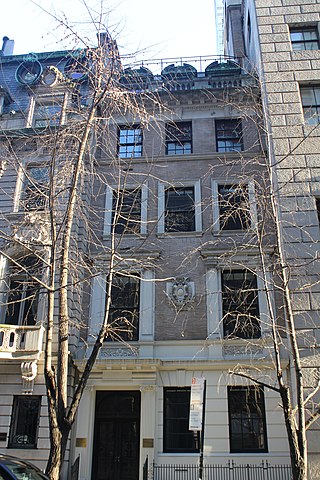
5 West 54th Street is a commercial building in the Midtown Manhattan neighborhood of New York City. It is along 54th Street's northern sidewalk between Fifth Avenue and Sixth Avenue. The four-story building was designed by R. H. Robertson in the Italian Renaissance Revival style and was constructed between 1897 and 1899 as a private residence. It is the easternmost of five consecutive townhouses erected along the same city block during the 1890s, the others being 7, 11, 13 and 15 West 54th Street. The first floor is clad with rusticated blocks of limestone, while the other floors contain buff-colored brick trimmed with limestone.
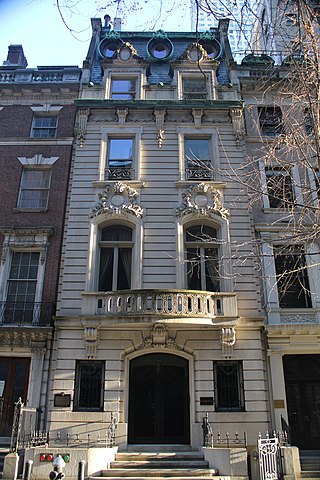
7 West 54th Street is a commercial building in the Midtown Manhattan neighborhood of New York City. It is along 54th Street's northern sidewalk between Fifth Avenue and Sixth Avenue. The four-story building was designed by John H. Duncan in the French Beaux-Arts style and was constructed between 1899 and 1900 as a private residence. It is one of five consecutive townhouses erected along the same city block during the 1890s, the others being 5, 11, and 13 and 15 West 54th Street.
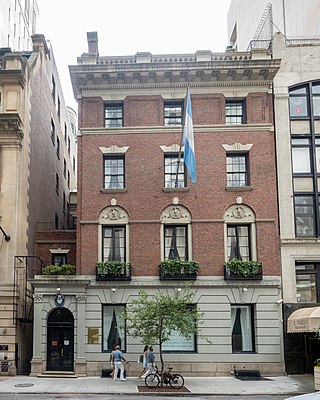
12 West 56th Street is a consular building in the Midtown Manhattan neighborhood of New York City, housing the Consulate General of Argentina in New York City. It is along 56th Street's southern sidewalk between Fifth Avenue and Sixth Avenue. The four-and-a-half story building was designed by McKim, Mead & White in the Georgian Revival style. It was constructed between 1899 and 1901 as a private residence, one of several on 56th Street's "Bankers' Row".

30 West 56th Street is a building in the Midtown Manhattan neighborhood of New York City. It is along 56th Street's southern sidewalk between Fifth Avenue and Sixth Avenue. The five-story building was designed by C. P. H. Gilbert in the French Renaissance Revival style. It was constructed between 1899 and 1901 as a private residence, one of several on 56th Street's "Bankers' Row".























